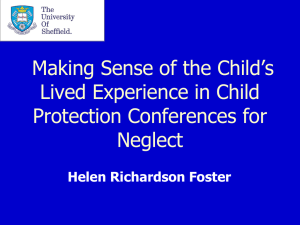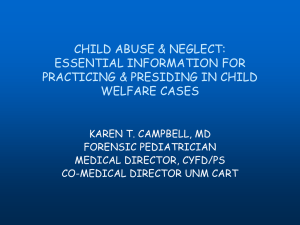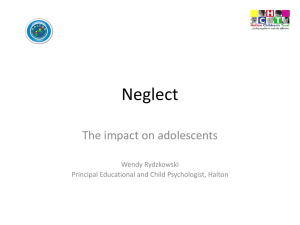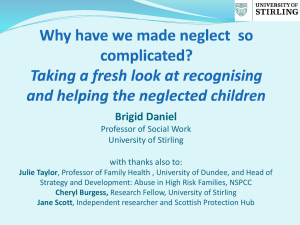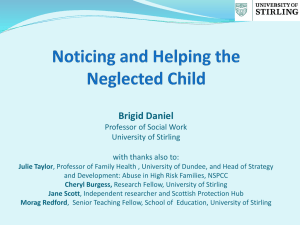Learning the Lessons – Ofsted Thematic Inspections
advertisement
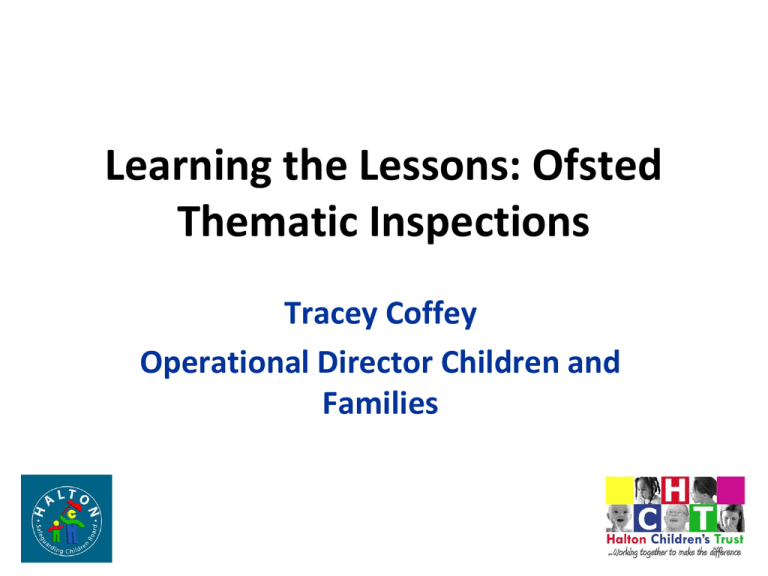
Learning the Lessons: Ofsted Thematic Inspections Tracey Coffey Operational Director Children and Families Ofsted Thematic Inspections • In the Child’s Time: professional responses to Neglect (March 2014) • From a distance: Looked After Children living away from their home area (April 2014) Both reports involved examining case records in a number of LAs, interviews with professionals, children young people and families and with the LSCBS for each area In the Child’s Time – Key Findings • The quality of professional practice in cases of neglect overall was found to be too variable, although in some of the cases examined at this inspection, children were making progress. • Nearly half of assessments in the cases seen either did not take sufficient account of the family history, or did not adequately convey or consider the impact of neglect on the child. Some assessments focused almost exclusively on the parents’ needs rather than analysing the impact of adult behaviours on children. In a small number of cases this delayed the action local agencies took to protect children from suffering further harm. In the Child’s Time – Key Findings • While the quality of written plans was found to be too variable, there was evidence of some very good support for children that was meeting the short-term needs of the family. However, there was very little evidence of longer-term support being provided to enable sustained change in the care given to the children. • Some authorities are using effective methods to map and measure the impact of neglect on children over time and to evaluate the effectiveness of interventions. This results in timely and improved decision-making in some cases. However, not all local authorities have such systems in place to support social workers in monitoring the impact of neglect on children and the effectiveness of their interventions. In the Child’s Time – Key Findings • Non-compliance and disguised compliance by parents were common features in cases reviewed. Although some multiagency groups adopted clear strategies to manage such behaviour, this was not evident in all cases. Where parents were not engaging with plans, and outcomes for children were not improving, professionals did not consistently challenge parents. • Drift was identified at some stage in the child’s journey in a third of all long-term cases examined, delaying appropriate action to meet the needs of children and to protect them from further harm. Drift was caused by a range of factors, including inadequate assessments, poor planning, parents failing to engage and in a small number of cases, lack of understanding by professionals of the cumulative impact of neglect on children’s health and development. In the Child’s Time – Key Findings • Front-line social workers and managers have access to research findings in relation to neglect, although the extent to which this is incorporated into practice varies. It is by exception that front-line social workers use specific research to support their work. The impact of training on professional practice with regard to neglect is neither systematically evident nor routinely evaluated. • Routine performance monitoring and reporting arrangements to LSCBs infrequently profile neglect. Most boards do not receive or collect neglect data except in respect of the number of child protection plans where the category is recorded as neglect. Most boards were not able to provide robust evidence of their evaluation and challenge about the effectiveness of tackling neglect. In the Child’s Time – Key Findings • Those local authorities providing the strongest evidence of the most comprehensive action to tackle neglect were more likely to have a neglect strategy and/or a systematic improvement programme across policy and practice, involving the development of specific approaches to neglect. • The challenge for local authorities and their partners is to ensure that best practice in cases of neglect is shared in order to drive improvement. In the Child’s Time – Recommendations - LSCB • LSCBs should: • have access to and regularly examine data and quality assurance information to enable them to monitor the quality of practice in relation to neglect across early help, child in need and child protection interventions • ensure that all agencies, including adult mental health services; drug and alcohol services; police and social work services working with families where there is domestic abuse; and services for adults with learning difficulties, work effectively together to assess and agree plans for children who experience neglect In the Child’s Time – Recommendations - LSCB • ensure that practitioners and their managers have access to highquality specialist training on the recognition and management of parental non- compliance and disguised compliance • ensure that the training provided for front-line practitioners and managers enables access to contemporary research and best practice in working with neglect • ensure that all staff are aware of their duty to escalate concerns when they consider that a child is not appropriately protected and/or is suffering from neglect, and that all agencies have appropriate escalation policies and procedures, including a procedure for challenging the decisions of children’s social care services where cases are not accepted for assessment or child In the Child’s Time – Recommendations - LAs • ensure that there is robust management oversight of neglect cases, so that drift and delay are identified and there is intervention to protect children where the risk of harm or actual harm, remains or intensifies. • prioritise the training and development of front-line practitioners, focusing on the skills needed to engage in direct work with families and the development of good assessments that describe what life at home is like for children. • support social workers and managers in the use of models and methods of assessment that enable them to effectively describe and analyse all risk factors in cases of neglect and then take decisive action where this is required In the Child’s Time – Recommendations - LAs • ensure that there is clarity about the threshold for care proceedings to be initiated in cases of neglect, and that the threshold is understood, consistently applied and monitored by local authority social care staff, senior managers and their legal advisers • oversee the written evidence presented to courts so that it is clear, concise and explicitly describes the cumulative impact of neglect on the daily life of the child. In the Child’s Time – Halton’s response • Neglect Strategy in final stages – launch events 16/18 July • Strategy highlights issues of neglect and impact in Halton supported by a clear delivery plan • HSCB will have the lead in overseeing and monitoring the impact of the Neglect Strategy • Graded Care Profile to be rolled out on multi-agency basis from September 2014 From a distance – Key Findings • Children were living outside their home local authority for a variety of reasons. Most commonly, it was due to a shortage of suitable carers close to home. • Children’s views were often taken into account. Inspectors saw some good examples of cases where listening carefully to children’s wishes and feelings had led to changes to their care plans. • Contact with children’s immediate families was generally well managed and promoted, although more could have been done to enable some children to see friends and members of their extended family. From a distance – Key Findings • Permanence planning and preparation work for young people to become independent were not consistently strong, although inspectors saw some examples of good practice. • Too often, the quality of the care and support that was provided to children was assessed and monitored by social workers without the appropriate level of expert advice from health or education specialists. This meant that decisions by managers about children living out of authority were not always based on high- quality assessments that fully described how children’s needs could be met. From a distance – Key Findings • Independent Reviewing Officers rarely contacted children living out of area between reviews and generally did not provide enough challenge to drift or delay in children’s plans. • Corporate parents did not give enough priority to assuring themselves that children living out of area were receiving high-quality care and support. • Careful matching of children to carers was much more likely to occur when agreeing for children to live with foster families than it was when the decision was for them to live at a children’s home. From a distance – Key Findings • There was often serious delay in securing support to promote children’s education and emotional well-being. • Too often, local authorities failed to notify other agencies properly when a looked after child had moved into their area. • Risks to some vulnerable children were not always adequately assessed and managed by the professionals involved and, in a small number of cases, poor professional practice contributed to further disruption and uncertainty in their lives. • Meeting the sufficiency duty remains a considerable challenge for most local authorities From a distance – Key Findings • Some local authorities did not have sufficient understanding of the needs of children placed in their area by other local authorities. LSCBs did not always monitor their needs closely enough. • The views of children living out of area did not influence overall service planning in any meaningful way. • The commissioning of independent placements for looked after children was underdeveloped in most authorities visited, lacking a clear focus on the outcomes required for children. From a distance – Recommendations LSCB • Monitor the performance of the local authority and partners in meeting the needs of all looked after children living in and out of the local authority area, paying particular attention to: • the extent to which specialist services are available • the sufficiency of education and health resources • the risks to children missing from care • the effectiveness of the local authority sufficiency strategy in reducing the number of children placed out of the area. From a distance – Recommendations LA • discharge their responsibilities as corporate parents properly, ensuring that they give high priority to the needs of looked after children living out of area and closely monitor the quality and impact of the care and support they receive • notify local agencies promptly before placements are made whenever a child moves into another local authority area, to ensure that appropriate health and educational services are immediately available • provide carers with timely, comprehensive information about the children and young people they are looking after From a distance – Recommendations LA • agree placement plans and confirm day-to-day arrangements at the start of placement, including clear arrangements to manage identified risks to children and young people • ensure that children’s educational progress and achievement is not compromised by a move out of area; virtual schools for looked after children should take the lead role in assessing the quality of out-ofauthority education provision and supporting all children looked after by the local authority, wherever they are living From a distance – Recommendations LA • establish full agreement for the funding of health provision in line with the responsibilities outlined in legislation and guidance, prior to children moving to their new home, so that there is continuity of health care for them when they live out of area • keep parents (where appropriate and safe to do so) fully informed about their children’s progress and ensure that contact for children with all friends and relatives who are important to them is not jeopardised by living out of area • ensure that workforce plans accommodate and prioritise time for social workers, independent reviewing officers and other professionals to develop meaningful, trusting and lasting relationships with looked after children From a distance – Recommendations LA • ensure that independent reviewing officers closely monitor, review and pursue good progress in the plans for children living out of area • ensure that the independent reviewing service manager reports regularly to senior leaders and managers in their capacity as corporate parents, on the overall progress of looked after children living out of area, with specific reference to any resource issues that may adversely affect the quality of care • ensure that commissioning and contracting arrangements with providers clearly focus on how the care and support provided to children can meet their needs and help them to make the required progress From a distance – Recommendations LA • develop a clear strategy to recruit carers based on an accurate analysis of current need, taking into account the known needs of children whose future needs may require care away from their families • ensure the sufficiency strategy to accommodate the need for children to be looked after close to home where this is safe for them • give children living at a distance from their home communities the same opportunities to influence the planning and delivery of services that are available to all children looked after. From a distance – Halton’s Response • Children in Care Partnership Board • Review of CAMHS Specification at Level 2 and current LA funded services • Sufficiency Strategy under review – develop more local provision • Foster Carer Recruitment Strategy Questions? • Do the thematic inspection reports findings reflect the experience in Halton? • What ideas/suggestions/solutions do you have to improve outcomes for children affected by neglect and children in care?
